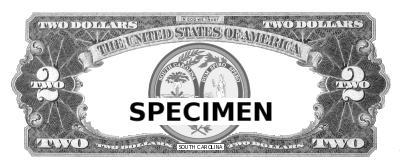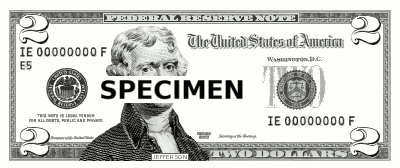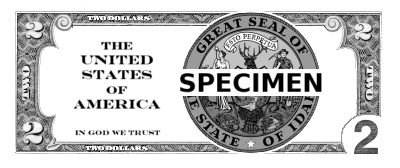

A tremendous amount of technical information is found at www.uspapermoney.info.
Introduction. Beyond doubt has been the popularity of the United States' quarter-dollar coin program (1999-2008) honoring each of the fifty states, as evidenced by the large number of collection folders offered by retailers. In fact, the schedule has been extended into 2009 to recognize several additional areas. In light of that success, this page offers a plan for printing two-dollar bills recognizing each of the nation's component jurisdictions.
There are important differences between this two-dollar proposal and the quarter-dollar program:
Still, the two programs have similarities:
We assume that these two-dollar bills (briefly, deuces or toms) would be issued as Federal Reserve Notes (FRNs).
Design of the individual bill. Of many options, one is a traditional approach combining the obverse of the 1976 FRN with the reverse of the 1963 United States Note. The reverse is modified by replacing Monticello with a jurisdiction seal, in this example South Carolina's:

| 
|
A modern version resembles FRNs of higher denominations ($5–$100) from the early 21st century. The large portrait, which is off center, suggests using a large jurisdiction seal (in this example Idaho's), also off center. The border of this reverse comes from the 1976 FRN.

| 
|
This portrait of Jefferson has also appeared on previous deuces: a Legal Tender Note of 1880 and a Federal Reserve Bank Note of 1918
Reverses of sheets. The Bureau of Engraving and Printing (BEP) generally produces notes in sheets of 32 subjects, 4 wide and 8 tall. We suggest printing two varieties of reverse sheets (called "X" and "Y" respectively), each with half the states and possessions. The two sheets should be printed in equal quantities.
One such pair of sheets, uncut, would likely appeal to a currency hobbyist, as all the jurisdictions would be represented. On the other hand, a strap of 100 new pieces would likely contain only one jurisdiction. A strap of new bills would have consecutive serial numbers in the absence of star notes, as with other United States currency.
The simplest plan is to print the obverses without regard for what jurisdictions appear on the respective reverses. A more complicated alternative is to coordinate the serial number on the front with the jurisdiction seal on the back; the arrangement of seals on the reverses is designed to facilitate this choice, which will be discussed later.
On each sheet are four leftover positions for which suitable designs need to be selected; an obvious default is the obverse or reverse of the seal of the United States.
Tables 1X and 1Y below show how to arrange the jurisdictions on the reverses. In each cell are:
The plate position information is printed only on the obverses of the actual notes, and is included in this table of reverses merely for reference.
| Table 1X: reverse of an "X" sheet | E3 41 MT Montana | A3 33 OR Oregon | E1 09 NH New Hampshire | A1 01 DE Delaware |
|---|---|---|---|---|
| F3 43 ID Idaho | B3 35 WV West Virginia | F1 11 NY New York | B1 03 NJ New Jersey | |
| G3 45 UT Utah | C3 37 NE Nebraska | G1 13 RI Rhode Island | C1 05 CT Connecticut | |
| H3 47 NM New Mexico | D3 39 ND North Dakota | H1 15 KY Kentucky | D1 07 MD Maryland | |
| E4 57 to be determined | A4 49 AK Alaska | E2 25 AR Arkansas | A2 17 OH Ohio | |
| F4 59 to be determined | B4 51 DC District of Columbia | F2 27 FL Florida | B2 19 IN Indiana | |
| G4 61 to be determined | C4 53 GU Guam | G2 29 IA Iowa | C2 21 IL Illinois | |
| H4 63 to be determined | D4 55 VI US Virgin Islands | H2 31 CA California | D2 23 ME Maine | |
| Table 1Y: reverse of a "Y" sheet | E3 42 WA Washington | A3 34 KS Kansas | E1 10 VA Virginia | A1 02 PA Pennsylvania |
| F3 44 WY Wyoming | B3 36 NV Nevada | F1 12 NC North Carolina | B1 04 GA Georgia | |
| G3 46 OK Oklahoma | C3 38 CO Colorado | G1 14 VT Vermont | C1 06 MA Massachusetts | |
| H3 48 AZ Arizona | D3 40 SD South Dakota | H1 16 TN Tennessee | D1 08 SC South Carolina | |
| E4 58 to be determined | A4 50 HI Hawaii | E2 26 MI Michigan | A2 18 LA Louisiana | |
| F4 60 to be determined | B4 52 PR Puerto Rico | F2 28 TX Texas | B2 20 MS Mississippi | |
| G4 62 to be determined | C4 54 AS American Samoa | G2 30 WI Wisconsin | C2 22 AL Alabama | |
| H4 64 to be determined | D4 56 MP Northern Mariana Islands | H2 32 MN Minnesota | D2 24 MO Missouri | |
Obverses of sheets. Desirable, but not required, is to coordinate the serial number on the obverse of the note with the jurisdiction seal on the reverse. Beyond manipulating the serial, no customization of the obverses for jurisdictions is proposed. In particular, any special treatment of the twelve Federal Reserve Bank districts will be difficult, because quantities printed for each can vary widely.
First plan. Sheets might be printed in runs of 10 thousand pairs of sheets yielding 640 thousand notes. Tables 2X and 2Y show the pattern of plate positions and serial numbers, while tables 3X and 3Y explain how numbering varies from sheet to sheet.
| Table 2X: obverse of first "X" sheet | A1 9901_0000 | E1 9909_0000 | A3 9933_0000 | E3 9941_0000 | Table 3X: obverses of subsequent "X" sheets | 9901_0001 through 9963_0001
9901_0002 through 9963_0002 9901_0003 through 9963_0003 et sequentia, ending with 9901_9999 through 9963_9999 |
|---|---|---|---|---|---|---|
| B1 9903_0000 | F1 9911_0000 | B3 9935_0000 | F3 9943_0000 | |||
| C1 9905_0000 | G1 9913_0000 | C3 9937_0000 | G3 9945_0000 | |||
| D1 9907_0000 | H1 9915_0000 | D3 9939_0000 | H3 9947_0000 | |||
| A2 9917_0000 | E2 9925_0000 | A4 9949_0000 | E4 9957_0000 | |||
| B2 9919_0000 | F2 9927_0000 | B4 9951_0000 | F4 9959_0000 | |||
| C2 9921_0000 | G2 9929_0000 | C4 9953_0000 | G4 9961_0000 | |||
| D2 9923_0000 | H2 9931_0000 | D4 9955_0000 | H4 9963_0000 | |||
| Table 2Y: obverse of first "Y" sheet | A1 9902_0000 | E1 9910_0000 | A3 9934_0000 | E3 9942_0000 | Table 3Y: obverses of subsequent "Y" sheets | 9902_0001 through 9964_0001
9902_0002 through 9964_0002 9902_0003 through 9964_0003 et sequentia, ending with 9902_9999 through 9964_9999 |
| B1 9904_0000 | F1 9912_0000 | B3 9936_0000 | F3 9944_0000 | |||
| C1 9906_0000 | G1 9914_0000 | C3 9938_0000 | G3 9946_0000 | |||
| D1 9908_0000 | H1 9916_0000 | D3 9940_0000 | H3 9948_0000 | |||
| A2 9918_0000 | E2 9926_0000 | A4 9950_0000 | E4 9958_0000 | |||
| B2 9920_0000 | F2 9928_0000 | B4 9952_0000 | F4 9960_0000 | |||
| C2 9922_0000 | G2 9930_0000 | C4 9954_0000 | G4 9962_0000 | |||
| D2 9924_0000 | H2 9932_0000 | D4 9956_0000 | H4 9964_0000 | |||
Second plan. The numerical part of the serial would be the same for all 64 notes in a pair of sheets, but each number would be prefixed by the two-letter abbreviation for the jurisdiction whose seal is borne on its reverse. Suffixed to the digits would be one letter signifying the Federal Reserve Bank issuing the note. In tables 4X and 4Y, "E" (for Richmond) was arbitrarily selected. For this plan, press runs can be of any convenient size.
In plate positions E4 through H4, arbitrary two-letter combinations beginning with X or Y fill the space where the jurisdiction abbreviation would go.
| Table 4X: obverse of "X" sheet | A1 DE 9426_3845 E | E1 NH 9426_3845 E | A3 OR 9426_3845 E | E3 MT 9426_3845 E |
|---|---|---|---|---|
| B1 NJ 9426_3845 E | F1 NY 9426_3845 E | B3 WV 9426_3845 E | F3 ID 9426_3845 E | |
| C1 CT 9426_3845 E | G1 RI 9426_3845 E | C3 NE 9426_3845 E | G3 UT 9426_3845 E | |
| D1 MD 9426_3845 E | H1 KY 9426_3845 E | D3 ND 9426_3845 E | H3 NM 9426_3845 E | |
| A2 OH 9426_3845 E | E2 AR 9426_3845 E | A4 AK 9426_3845 E | E4 XE 9426_3845 E | |
| B2 IN 9426_3845 E | F2 FL 9426_3845 E | B4 DC 9426_3845 E | F4 XF 9426_3845 E | |
| C2 IL 9426_3845 E | G2 IA 9426_3845 E | C4 GU 9426_3845 E | G4 XG 9426_3845 E | |
| D2 ME 9426_3845 E | H2 CA 9426_3845 E | D4 VI 9426_3845 E | H4 XH 9426_3845 E | |
| Table 4Y: obverse of "Y" sheet | A1 PA 9426_3845 E | E1 VA 9426_3845 E | A3 KS 9426_3845 E | E3 WA 9426_3845 E |
| B1 GA 9426_3845 E | F1 NC 9426_3845 E | B3 NV 9426_3845 E | F3 WY 9426_3845 E | |
| C1 MA 9426_3845 E | G1 VT 9426_3845 E | C3 CO 9426_3845 E | G3 OK 9426_3845 E | |
| D1 SC 9426_3845 E | H1 TN 9426_3845 E | D3 SD 9426_3845 E | H3 AZ 9426_3845 E | |
| A2 LA 9426_3845 E | E2 MI 9426_3845 E | A4 HI 9426_3845 E | E4 YE 9426_3845 E | |
| B2 MS 9426_3845 E | F2 TX 9426_3845 E | B4 PR 9426_3845 E | F4 YF 9426_3845 E | |
| C2 AL 9426_3845 E | G2 WI 9426_3845 E | C4 AS 9426_3845 E | G4 YG 9426_3845 E | |
| D2 MO 9426_3845 E | H2 MN 9426_3845 E | D4 MP 9426_3845 E | H4 YH 9426_3845 E | |
Colors. An obvious choice is to retain the ink colors of recent FRNs, with serial numbers and treasury seal in green, other parts of the obverse in black, and the reverse in green.

| 
|
Less conventional is to have the obverses of the "X" sheets printed in black as usual, except with red serial numbers and treasury seals, and the reverse printed in blue, not the traditional green. Meanwhile, the "Y" sheets would have blue serials and treasury seals, and red backs. This way, each note would be rendered in the national colors: red and blue from the inks, and white from the paper (which itself contains tiny red and blue fibers).
| "X" sheets | 
| 
|
|---|---|---|
| "Y" sheets | 
| 
|
The use of colors other than black and green on United States currency is well precedented.
Incidental suggestion. The United States five-dollar bill as printed since 1928 has borne on its reverse an engraving of the east face of the Lincoln Memorial, on which are carved the names of only 26 out of the 50 states. With a small sacrifice of pictorial accuracy, the BEP could produce two versions of the reverse of this note, each with half of the states. At printing, each sheet of 32 notes could have 16 instances of each version, meaning that all states would be equally represented.